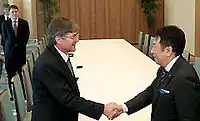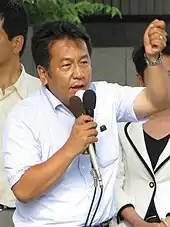Yukio Edano
Yukio Edano (枝野 幸男, Edano Yukio, born 31 May 1964) is a Japanese politician who served as the leader of the Constitutional Democratic Party of Japan from its formation in 2017 until 2021.[1] A member of the House of Representatives in the Diet since 1993, he served as Chief Cabinet Secretary and Minister of Economy, Trade and Industry in the Democratic Party of Japan (DPJ) government from 2010 to 2012.[2]
Yukio Edano | |
|---|---|
枝野 幸男 | |
_(cropped).jpg.webp) Edano in 2020 | |
| Leader of the Constitutional Democratic Party | |
| In office 2 October 2017 – 12 November 2021 | |
| Deputy | Akira Nagatsuma |
| Preceded by | Position established |
| Succeeded by | Kenta Izumi |
| Minister of Economy, Trade and Industry | |
| In office 12 September 2011 – 26 December 2012 | |
| Prime Minister | Yoshihiko Noda |
| Preceded by | Yoshio Hachiro |
| Succeeded by | Toshimitsu Motegi |
| Chief Cabinet Secretary | |
| In office 4 January 2011 – 2 September 2011 | |
| Prime Minister | Naoto Kan |
| Preceded by | Yoshito Sengoku |
| Succeeded by | Osamu Fujimura |
| Minister of State for Government Revitalisation | |
| In office 27 June 2011 – 2 September 2011 | |
| Prime Minister | Naoto Kan |
| Preceded by | Renhō |
| Succeeded by | Renhō |
| Minister of State for Okinawa and Northern Territories Affairs | |
| In office 14 January 2011 – 2 September 2011 | |
| Prime Minister | Naoto Kan |
| Preceded by | Sumio Mabuchi |
| Succeeded by | Tatsuo Kawabata |
| Minister of Foreign Affairs | |
| Acting 7 March 2011 – 9 March 2011 | |
| Prime Minister | Naoto Kan |
| Preceded by | Seiji Maehara |
| Succeeded by | Takeaki Matsumoto |
| Minister of State for Government Revitalisation | |
| In office 10 February 2010 – 8 June 2010 | |
| Prime Minister | Yukio Hatoyama |
| Preceded by | Yoshito Sengoku |
| Succeeded by | Renhō |
| Member of the House of Representatives | |
| Assumed office 19 July 1993 | |
| Constituency |
|
| Personal details | |
| Born | 31 May 1964 Utsunomiya, Japan |
| Political party | CDP |
| Other political affiliations | JNP (1992–1994) NFP (1994–1998) DPJ (1998–2016, merger) DP (2016–2017, split) |
| Spouse | Kazuko Edano |
| Children | 2 |
| Alma mater | Tohoku University |
| Website | www |
Following the CDP's poor performance in the 2021 general election, Edano announced on 2 November his intention to resign as leader of the party, triggering a leadership election.[3]
Early life
Edano was born in Utsunomiya on 31 May 1964. He is named after Japanese progressive liberal political figure Yukio Ozaki, who Edano's father admired. Edano graduated from Tohoku University with a degree in law, and passed the Japanese bar examination at the age of 24.[4]
Political career
In the 1993 general election, at the age of 29, Edano joined Morihiro Hosokawa's Japan New Party and won a seat in the Saitama 5th district.[4] He participated in the formation of the DPJ in 1996.
As a legislator, Edano played a role in the government response to the HIV-tainted blood scandal of 1995 and the financial industry reorganization of 1998.[4]
Edano was appointed as the secretary general of the DPJ in March 2010 when it was the country's ruling party. Katsuya Okada, the former Foreign Minister, subsequently replaced him in September 2010.
Chief Cabinet Secretary

In January 2011, Edano became Chief Cabinet Secretary in the Kan Cabinet.[5] In March 2011, he was temporarily appointed head of the Foreign Ministry.[6]
In the wake of the 2011 earthquake and tsunami in northeastern Japan, he was the face of the government efforts to combat the aftermath, frequently appearing on television to talk about the problems at the two reactor facilities in Fukushima. Because of the frequency of his appearances, Twitter users concerned with his health were prompted to post messages asking him to get some sleep. The Twitter hashtag "#edano_nero" became popular, from the imperative word for sleep! (寝ろ, nero) in Japanese.[7][8]
Minister of Economy, Trade and Industry
As economy minister in the Noda Cabinet, Edano approved the introduction of feed-in tariffs on 18 June 2012, whereby a percentage of energy use fees are used to subsidize (a shift to) renewable energy.[9]
Post-cabinet

Edano left the Cabinet following the DPJ's defeat in the December 2012 general election, but retained his seat representing the Saitama 5th district.
Edano was named secretary general of the DPJ in September 2014. He retained this position in the Democratic Party following the merger of the DPJ with the Japan Innovation Party in March 2016.[10]
DP leader Renho resigned in July 2017 after the party suffered a poor result in the 2017 Tokyo assembly election. With the liberal wing of the party losing clout due to the influx of conservative Japan Innovation Party members after the merger, Edano only managed to garner 40% of the points up for grabs in the election.[11] In an attempt to unify the party, the freshly-elected leader Maehara appointed Edano as the deputy president.[12]
Constitutional Democratic Party
_(cropped).jpg.webp)
Prime Minister Shinzo Abe made a surprise announcement for a snap election on 25 September 2017, only three weeks after the DP leadership election. With the party unprepared and in disarray, Maehara was scrambling to find a way to shore up support for the party. At the same day as Abe's election announcement, Tokyo Governor Yuriko Koike launched a new conservative party called Kibō no Tō (Party of Hope). Seeing Koike's high popularity at that time as a potential asset, Maehara coordinated with Koike on DP candidates' nominations for the election. Koike agreed to endorse DP candidates and Maehara effectively disbanded the party in order to allow the candidates run under the Kibō banner. However, despite Maehara's request, Koike imposed an ideological filter that effectively barred liberal-leaning members of the DP, such as Edano, from joining Kibō. Edano then decided to form a separate party to house liberal DP members rejected by Koike.[13]
On 2 October 2017, Edano founded the Constitutional Democratic Party as a split from the Democratic Party, becoming the party's leader.[14] Despite being formed only less than three weeks before the election, the CDP ran a very efficient campaign with a principled platform and used social media in a level unprecedented in Japanese politics.[15][16] Edano led the party to become the second largest party in the Diet in the general election.
He won the 2020 Constitutional Democratic Party of Japan leadership election, before resigning following the 2021 Japanese general election.[17] In 2023, after three years of serving without a party poisiton, it was rumored he wanted to take back leadership of the CDP following Kenta Izumi's failure to recapture momentum in the party. He released a revised version of the "Edano Vision", a manifesto he published when he served as party leader, in August 2023.[18]
Political views
Edano has described himself as both liberal and conservative, believing the labels do not conflict with one another. He supports separate surnames for married couples.[19]
Controversy
On March 27, 2010, on the centennial of Japan–Korean annexation, Yukio Edano, then Japanese Minister of State for Government Revitalization, stated that "The invasion and colonization of China and Korea was historically inevitable ... since China and Korea could not modernize themselves."[20]
Family
Edano is married and has twin sons.[4]
References
- "Edano's new liberal party to field more than 50 candidates in Lower House election". October 4, 2017 – via Japan Times Online.
- Reuters, "Japan picks Edano as trade min after predecessor gaffe", 11 September 2011
- "CDP leader Yukio Edano to quit post after poor election results". The Japan Times. November 2, 2021. Retrieved November 2, 2021.
- "Yukio Edano Profile". Retrieved July 14, 2016.
- "Kan revamps cabinet to boost his popularity". Japan Today. Kyodo News. January 14, 2011. Retrieved March 14, 2011.
- "Edano named as temporary minister: Kan". The Japan Times. March 8, 2011. Retrieved March 14, 2011.
- "Tireless Edano Earns Twitter Respect". The Wall Street Journal. March 14, 2011. Retrieved March 14, 2011.
- "Japan earthquake: Yukio Edano, the 'Jack Bauer' of the crisis". The Telegraph. March 15, 2011. Retrieved July 14, 2016.
- Gerhardt, Tina (July 22, 2012). "Japan's People Say NO to Nuclear Energy". Alternet.
- "Okada to appoint Edano as secretary-general of new Democratic Party". The Mainichi. March 24, 2016. Retrieved July 13, 2016.
- "Long-suffering Democratic Party elects Maehara". Asahi Shimbun. September 1, 2017. Retrieved December 18, 2017.
- "Ex-prosecutor to be tapped for Democratic Party's No. 2 slot". Asahi Shimbun. September 3, 2017. Retrieved December 18, 2017.
- "Edano plans to form new party as liberal force in election". Asahi Shimbun. October 2, 2017. Retrieved December 17, 2017.
- "2017 Lower House Election / Edano announces launch of new party of liberals". Yomiuri Shimbun.
- Martin, Alex; Kikuchi, Daisuke (October 22, 2017). "Top opposition forces see contrasting fates after poll". Japan Times. Retrieved December 13, 2017.
- Penn, Michael (November 3, 2017). "The Reversal of Fortune". Shingetsu News Agency. Retrieved December 18, 2017.
- "合流新党、代表選は立憲vs国民 枝野氏・泉氏一騎打ち:朝日新聞デジタル". 朝日新聞デジタル (in Japanese). Retrieved June 1, 2022.
- Jiji, Staff Report (October 1, 2023). "Yukio Edano moves to return as CDP leader". Retrieved October 6, 2023.
- Soredemo seiji wa kaerareru : Shiminha wakate giin no funsenki. Yukio Edano, 幸男 枝野. マネジメント伸社. 1998. ISBN 4-8378-0393-8. OCLC 676160904.
{{cite book}}: CS1 maint: others (link) - "되풀이되는 日 고위직 망언 구제불능인가" [Are the repeated controversial remarks of high-ranking Japanese officials beyond redemption?]. Editorial. Seoul Shinmun (in Korean). March 29, 2010. Retrieved January 2, 2016.